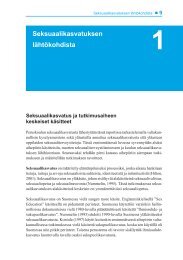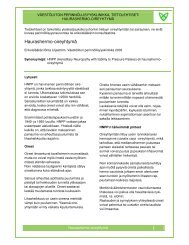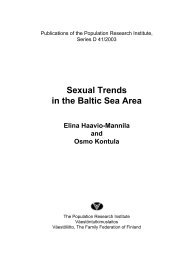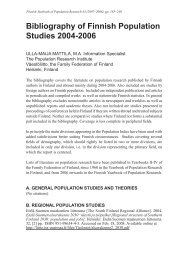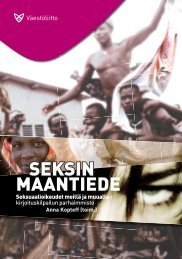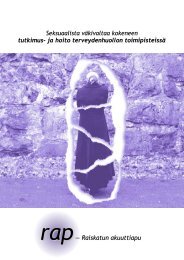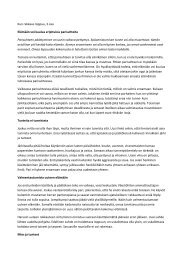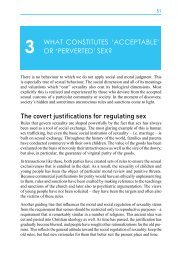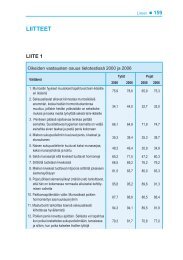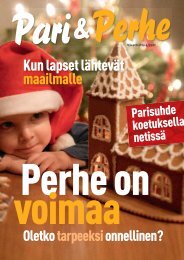When One Does Not Want to Be Like Others: The Basis ... - Väestöliitto
When One Does Not Want to Be Like Others: The Basis ... - Väestöliitto
When One Does Not Want to Be Like Others: The Basis ... - Väestöliitto
You also want an ePaper? Increase the reach of your titles
YUMPU automatically turns print PDFs into web optimized ePapers that Google loves.
153<br />
Yearbook of Population Research in Finland 40 (2004), pp. 153–171<br />
<strong>When</strong> <strong>One</strong> <strong>Does</strong> <strong>Not</strong> <strong>Want</strong> <strong>to</strong> <strong>Be</strong><br />
<strong>Like</strong> <strong>Others</strong>: <strong>The</strong> <strong>Basis</strong> of the Sense<br />
of Control Among Conservative<br />
Laestadian Mothers With Large<br />
Families<br />
LEENA PESÄLÄ, Doc<strong>to</strong>ral Student<br />
Department of Psychology<br />
University of Joensuu, Finland<br />
Abstract<br />
Large families are the most characteristic feature of the Conservative Laestadian<br />
revivalist movement. In this research project belonging <strong>to</strong> the fi eld of psychology my<br />
aim is <strong>to</strong> describe the facts on which the sense of control of the Laestadian mothers<br />
with large families is based. My research method is a qualitative contents analysis.<br />
<strong>The</strong> results indicate that the mothers’ personal faith is the most important element in<br />
their sense of control. <strong>The</strong> values based on the Conservative Laestadian beliefs give<br />
a clear and safe structure for life. <strong>The</strong> most important role of the spouse is <strong>to</strong> support<br />
his wife emotionally, socially and spiritually. <strong>Be</strong>hind the active parenthood of the<br />
mothers are the life management skills acquired in their families of origin as well as<br />
the experience acquired from motherhood. Family members share both mental and<br />
physical responsibilities, consequently supporting the mother. <strong>The</strong> mothers did not<br />
experience that they should not behave according <strong>to</strong> the family planning practises<br />
characteristic of our time. <strong>The</strong>y do not want <strong>to</strong> be like others.<br />
Keywords: Conservative Laestadianism, personal faith, sense of control, life management,<br />
large families, life span of a family, Finland<br />
At the foot of the wall<br />
In Finland, 84.6% of the <strong>to</strong>tal population belong <strong>to</strong> the Lutheran church.<br />
Laestadianism was born as a result of the spiritual work of Lars Levi Laestadius<br />
(1800–1861) and it is the biggest revivalist movement functioning within the sphere<br />
of the Lutheran Church. In Finland it has 100,000 members, which is 2.3% of the<br />
members of the church. Laestadianism is divided in<strong>to</strong> many different groups and<br />
the majority of these groups, including approximately 80,000 people, represents<br />
Conservative Laestadianism. It is considered that the actual year of birth of the
154<br />
movement is 1846. <strong>The</strong> revivalist movement began in Kaaresuvan<strong>to</strong> in Sweden and<br />
it soon spread <strong>to</strong> surrounding parishes in Sweden, Finland and Norway. From the<br />
very outset Laestadianism became a common movement of the Finns and Sami living<br />
in the Arctic Area of the Nordic countries, whereas in the Swedish and Norwegian<br />
speaking areas it has gained relatively small support. (Lohi 1997, 2003.) At present,<br />
Laestadianism exists in different forms also in Russia, Es<strong>to</strong>nia, Latvia, Hungary,<br />
Germany, England, the United States and Canada. <strong>The</strong> movement has spread with<br />
either immigrants or missionaries. <strong>The</strong> main organisation of the conservative<br />
Laestadianism in Finland is <strong>The</strong> Central Association of the Finnish Associations<br />
of Peace (Suomen Rauhanyhdistysten Keskusyhdistys, SRK). On the local level,<br />
Associations of Peace (rauhanyhdistykset) organise activities and there are about<br />
200 of them. Of the religious movements existing in Finland, Laestadianism is the<br />
most individual one and its influence on the everyday lives of its supporters is the<br />
strongest. <strong>The</strong> Laestadian membership identity is clear. As a consequence there are<br />
only few marginal members among the supporters of this movement. (Lohi 2003.)<br />
In this study the term Laestadianism refers <strong>to</strong> Conservative Laestadianism.<br />
Throughout its his<strong>to</strong>ry in Finland Laestadianism has been separated from dominant<br />
culture (Lohi 1997). <strong>The</strong> mothers participating in my study regarded the people outside<br />
the movement as non-believers, “others”. My desire was look over this wall of<br />
attitudes. How do mothers with large families carry on, when motherhood is usually<br />
experienced as something tiring (Jokinen 1996) In terms of the number of children<br />
my study is between two discourses. <strong>The</strong> first one is the worry about lower birth<br />
rates and the second is the positive public image of the individualistic small family<br />
model (Paajanen 2002). Laestadian families have followed their values and gone<br />
against the mainstream of family planning with their determination <strong>to</strong> give birth. At<br />
present, giving multiple births is considered an act of braveness in Finland, and even<br />
the privilege of the well-educated and higher social groups (Nopola 1991).<br />
Cultural background, above all religious beliefs, is the biggest motivation <strong>to</strong> wish<br />
for a large family. <strong>The</strong> Family Federation of Finland reports that in the province of<br />
Oulu, where the Laestadian revivalist movement is strongly supported, there is the<br />
highest ideal number of children in Finland according <strong>to</strong> the family barometer of<br />
2002 (Paajanen 2002, 25). In the same region the birth rate is higher than in general.<br />
While the <strong>to</strong>tal fertility figure in our country in 2000 was 1.7 on the average, it was<br />
as much as 3.1 in some places in the province of Oulu (Paajanen 2002, 9; Statistics<br />
Finland 2002). According <strong>to</strong> a study by Kaisa Juntunen (1997, 722) it is common<br />
among the members of the Laestadian movement that families have more than 10<br />
children. <strong>The</strong> largest family included in her study had 21 children (ibid).<br />
Motherhood can be happiness and enjoyment as well as a trap of bad conscience,<br />
loneliness and poverty (Nätkin 1997, 173–175). According <strong>to</strong> Eeva Jokinen (1996)
155<br />
the most frequently mentioned feeling about motherhood is tiredness. Primitive,<br />
instinctive urge <strong>to</strong> reproduce is part of the desire for being a mother, but it is a<br />
social phenomenon, <strong>to</strong>o (ibid., 21–22). Finnish mothers do not typically experience<br />
motherhood as their destiny any longer, but a conscious desire (Nopola 1991, 70).<br />
For the women participating in my study it is both. <strong>The</strong> spouses of the women are<br />
Laestadian. Having the same faith is typical of married Laestadian couples, because the<br />
Bible instructs <strong>to</strong> look for a wife who is “a daughter of Zion”. While a typical Finnish<br />
family of mainstream culture is nowadays individualistic and small, the Laestadian<br />
concept of the family is still based on the Bible (see e.g. Jallinoja 2000).<br />
Laestadianism is a very family-orientated, revivalist movement. Its set of values,<br />
such as love for one’s neighbour, openness, fidelity and sobriety protect marriages.<br />
Divorces are rare, although exact, statistical research does not exist on the subject.<br />
Statistically, one third of Finnish marriages end in divorce and in younger age groups<br />
the number is as high as half (Statistics Finland 2001, 22). Studies in this field indicate<br />
that there are three reasons behind long-lasting marriages. Firstly, there is a warm<br />
and loving relationship between the couple. Secondly, children, finances or habit can<br />
keep the spouses <strong>to</strong>gether. Thirdly, religious or moral beliefs can be an explana<strong>to</strong>ry<br />
fac<strong>to</strong>r. (Weishaus and Fields 1988; Tolkki-Nikkonen 1990.) Similar temperaments,<br />
desires, values and attitudes of the spouses predict satisfaction in the relationship<br />
(Rytkönen and Hautsalo 1999). Laestadianism connected the women in my study <strong>to</strong><br />
their husbands, although according <strong>to</strong> research social similarity and religion do not<br />
relate significantly <strong>to</strong> the quality of the relationship (ibid., 59–60).<br />
<strong>The</strong> number of children has an impact on their child rearing practices. A large family<br />
can be a threat <strong>to</strong> the development of individualism, whereas a small family<br />
can lead <strong>to</strong> living on the child’s terms (Kemppainen 2001, 152; Korhonen 1994). A<br />
parental style does not necessarily transfer from the family of origin <strong>to</strong> one’s own<br />
family (Harmainen and Ruoppila 1984). <strong>The</strong> life style of a family also depends on<br />
where the family is (Tolkki-Nikkonen 1990; Goldenberg and Goldenberg 1991,<br />
16). Industriousness and diligence have traditionally been appreciated in Finnish<br />
families, but more and more often communication skills and individualism are also<br />
valued. <strong>The</strong> actions of mothers have been characterised by care. (Korhonen 1994.)<br />
In traditional peasant families, daughters have faced a risk, as a consequence of the<br />
family structure, <strong>to</strong> experience lack of motherly love. <strong>The</strong> families have been large,<br />
like Laestadian families still are nowadays, and the mother has spent her time on<br />
chores in the house. <strong>The</strong> only adult supporting the upbringing of the daughters might<br />
have been their grandmother. (Apo 1995, 243.)<br />
<strong>The</strong> theoretical concept central in this study is the sense of control. It refers <strong>to</strong> a<br />
person’s belief in the possibility of influencing one’s own life (Pulkkinen 1997,<br />
174). <strong>The</strong> sense of control consists of experiences of being in charge of everyday
156<br />
life. It is adjustment <strong>to</strong> the changing situations of life by using psychological, physical<br />
or social means of life management (see e.g. Vuorinen 1991). An individual<br />
positions the motivation directing his behaviour either in his inner resources or in<br />
the external circumstances independent of himself (Nurmi, Eronen and Salmela-<br />
Aro 2001, 105–106). An inner way of life management can develop in challenging<br />
situations. A person adjusts – “sees things in the best possible light”. (Roos 1987;<br />
1988, 207.) To achieve a sense of control one can try <strong>to</strong> change either the stressful<br />
situation or the importance of that situation, or <strong>to</strong> regulate his emotions by different<br />
means when already under stress (Pearlin and Schooler 1978). Psychological means<br />
are for example distancing, looking for social support, planned problem solving,<br />
accepting responsibility and positive revaluation (Lazarus and Folkman 1984).<br />
Data and method<br />
<strong>When</strong> collecting data I went through four different stages. During the first stage I<br />
acquired pre-understanding of the Laestadian family model and set of values by<br />
reading publications of SRK. During the second stage in 2000, I looked for subjective<br />
experiences in motherhood and sent a request for essays on the subject <strong>to</strong> a<br />
Christian folk high school based on the values of Laestadianism. <strong>The</strong>re were courses<br />
on motherhood organised at this school. Based on the values mentioned in the publications<br />
of SRK I asked the mothers participating in the above-mentioned courses <strong>to</strong><br />
write about the significance of relationships, family, relatives and friends (see Apo<br />
1980). During the third stage in the autumn of 2000, I conducted a focus group interview<br />
at another folk high school. I had chosen the themes of the half-constructed<br />
interview using the information I had gathered during the first and second stages.<br />
During the fourth stage, when analysing the data from the essays and focus group<br />
interview I returned <strong>to</strong> the publications of SRK. So, these publications became not<br />
only the material for the pre-understanding, but also “the comparison data” for the<br />
data gathered at the interview. <strong>The</strong> comparison data had a twofold significance. On<br />
one hand, I compared the interviews with the published values of Laestadianism,<br />
and on the other hand, I searched for a better understanding of the mothers’ s<strong>to</strong>ries<br />
with the help of this data.<br />
Three of the 29 women taking part in the course on motherhood replied <strong>to</strong> my request<br />
for writing essays. <strong>The</strong> number of children they had was between six and sixteen. I<br />
assume that the reason for so few replies is the amount of work involved in writing<br />
essays. <strong>The</strong> way I had set the questions in the request had an effect on the contents<br />
of the essays. In addition, the themes discussed during the course on motherhood can<br />
have affected the essays. <strong>The</strong> focus group was formed by six mothers out of 22 that<br />
had participated in a course on Finnish perseverance. <strong>The</strong> form of the interview was<br />
half-structured theme interview (see e.g. Hirsjärvi and Hurme 2001). <strong>The</strong> mothers<br />
had chosen the participants among themselves. I assume that the mothers who were
157<br />
chosen were considered by the group <strong>to</strong> possess the best knowledge of motherhood<br />
in a large family. <strong>The</strong> group members at a focus interview should have a clear view<br />
on the phenomenon that is being examined (see e.g DesRosier and Zellers 1989). <strong>The</strong><br />
group did consist of mothers with a number of children ranging from eight <strong>to</strong> eleven.<br />
<strong>The</strong> group interview helped <strong>to</strong> understand the structural significance and attitudes of<br />
Laestadian mothers. However, individualism and deviant points of view may have<br />
disappeared due <strong>to</strong> possible control of the group (see Pötsönen and Pennanen 1998,<br />
1–4). Individual points of view were hard <strong>to</strong> distinguish.<br />
<strong>The</strong> women in my study had 9.5 children on the average. <strong>The</strong> age groups of the<br />
mothers varied from young adult <strong>to</strong> middle-aged. Erja, Liisa and Maire participated<br />
in the project by writing essays. Auli, Hanna, Irja, Jaana, Ritva and Terttu <strong>to</strong>ok part<br />
in the group interview. Erja and Ritva were already grandmothers. <strong>The</strong> mothers’<br />
names and other identifying information have been changed.<br />
At the stage of analysing the data I used the essays and focus group interview as<br />
equal sources of information. Throughout the whole research process I simplified and<br />
classified themes contributing <strong>to</strong> the sense of control. At the first stage of research<br />
my classification was based on the published values of SRK. After the second and<br />
third stages of research I classified the elements of the sense of control according<br />
<strong>to</strong> the data, ie based on the subjective experiences of the mothers. New themes<br />
surfaced. Instead of examining solely the contents, I also studied the figures of speech<br />
the women employed while speaking about their lives, as well as the subjects that<br />
were not discussed at all. Links between different things, which is characteristic of<br />
Laestadianism, were also significant. At the fourth stage I compared the themes of<br />
the publications of SRK and the themes based on the mothers’ interviews, since the<br />
classification could not be based solely on the data gathered at the interviews. So, this<br />
study was based on the contents analysis of these two types of themes. In addition,<br />
my aim was <strong>to</strong> compare my interpretations of the data with previous studies and<br />
theories on life management.<br />
Since I was climbing up a wall, I called the themes of my study “steps”. <strong>The</strong> hierarchy<br />
of my steps is based on the significance of the theme in relation <strong>to</strong> the mothers’ sense<br />
of control. <strong>The</strong> first step is the personal faith. <strong>The</strong> mothers stated that it was the most<br />
important element in their sense of control and the publications of SRK agreed. <strong>The</strong><br />
second step is motherhood, because it affected the sense of control not only as a<br />
demanding experience, but also as a satisfying one. This theme was present in the<br />
publications of SRK, but its importance was not significant. <strong>The</strong> Laestadian family<br />
model and its transfer from one generation <strong>to</strong> the next was the foundation for having<br />
a large family, but this theme was not emphasized in the mothers’ interview data.<br />
However, according <strong>to</strong> the literature of SRK the heritability of the family model<br />
seemed <strong>to</strong> be significant. Laestadian faith was “the sun of the grandfather” and
158<br />
therefore the inherited family model is my third step. <strong>The</strong> most important supporter<br />
of the mothers was their own husband, and so they are my fourth step. <strong>The</strong> fifth<br />
step is the children and family. Friends, hobbies and the support of the religious<br />
community were important <strong>to</strong> many of the mothers and therefore they are the sixth<br />
step. According <strong>to</strong> the literature of SRK the importance of this step should have<br />
been more essential.<br />
First step: Personal faith and the Laestadian worldview<br />
According <strong>to</strong> Laestadius’s concept of faith, fac<strong>to</strong>r uniting all believers is the love<br />
born out of living faith (Lohi 2003). It is typical of religious movements with<br />
clear membership identity, like amishes, that the members also have a common<br />
language and common cus<strong>to</strong>ms (Vesterinen 1992). In addition <strong>to</strong> religious beliefs,<br />
the supporters of Laestadianism also have similar habits based on the language and<br />
cus<strong>to</strong>m. <strong>The</strong>y say “they are in faith” and use “God’s greetings” in their greetings.<br />
<strong>When</strong> saying good-bye “God’s peace” is used. <strong>The</strong> mothers in my study use “nonbelievers”,<br />
“faithless” and “the people of the world” for people outside the movement.<br />
Confession, asking for forgiveness and granting forgiveness “in the name and blood<br />
of Jesus until joy, peace and freedom” are characteristic features of the Laestadian<br />
movement (Lohi 2002, 97). I call this principle the model of forgiveness. Although<br />
the mothers in the interview did not belittle other religious groups, the only right<br />
option for them is <strong>to</strong> belong <strong>to</strong> their spiritual home, ie Laestadianism.<br />
In the women’s opinion, conscience was the medium of God’s speech and guidance.<br />
“<strong>The</strong>re [at the meetings of the Association of Peace] it is not said what we can and<br />
cannot do, but we ourselves (…) want <strong>to</strong> do it, for example have children”, said Auli.<br />
For her part Erja wrote: ”It is no use <strong>to</strong> do against your conscience. That only damages<br />
your soul. God has made a human being so wonderful, we have souls and people<br />
are responsible for their actions.” According <strong>to</strong> Antti Paananen (2002), who wrote<br />
in the publication of SRK called Päivämies, for Laestadians conscience is not solely<br />
a feeling of your own, but “a common understanding of the complete authority of<br />
God’s will created by the Holy Spirit”. Auli relates that children learn <strong>to</strong> distinguish<br />
between right and wrong through parenting, events organised by the Associations of<br />
Peace and publications of SRK. <strong>The</strong> values and life experiences internalized in this<br />
way formed schemes and mental images for the cultural identity and worldview of<br />
a Laestadian (see Nurmi et al. 2001, 105). Adjusting <strong>to</strong> life situations was adjusting<br />
<strong>to</strong> the will of God within the framework of Laestadian values. That is why religious<br />
beliefs were one element of the inner sense of control.<br />
<strong>The</strong> women accepted the alternation of happiness and unhappiness in life as God’s<br />
will. According <strong>to</strong> Maire the strategy of life manifests itself as follows: “if His [God]<br />
intention is different, you have <strong>to</strong> be satisfied with it, because His works are perfect”.
159<br />
Irja explained how transferring the responsibility <strong>to</strong> God relieved her own burden:<br />
“…in a way you leave the fi nal decision in somebody else’s [God’s] hands. <strong>The</strong>n<br />
you just settle with that.” Auli agreed: “It does make it easier when I do not have the<br />
responsibility for all these things, but in a way it is in higher hands.” Ritva states<br />
that a Laestadian mother does not have <strong>to</strong> be strong herself: “You do not need your<br />
own strength anyway. You do not have <strong>to</strong> think that I’m such a strong person and I<br />
can handle it, but God gives the strength <strong>to</strong> that person regardless.” <strong>The</strong> mothers’<br />
life management skills were enhanced by the experience of managing the role of a<br />
Laestadian mother. <strong>The</strong>refore they denied themselves the means of control unsuitable<br />
for their set of values and by doing so they strengthened the justification for their<br />
own life style. A case in point is Irja relating how she prayed for a sabbatical from<br />
the repeated pregnancies as a relief from the tiredness caused by multiple births.<br />
Leaving everything in the hands of God was the foundation for everything. <strong>The</strong><br />
Laestadian cultural identity guided the choices of the means of life management, and<br />
these means enabled the mother <strong>to</strong> achieve the sense of control on a personal level.<br />
Thus, the sense of control consisted of faith and the means of life management.<br />
Auli, Erja and Ritva had studied as adults. At that time Auli had nine, Erja sixteen<br />
and Ritva four children. <strong>The</strong> narrations of that time were examples of “the fruit of<br />
faith” offered by God. Auli and Erja said that they had previously given up their<br />
studies <strong>to</strong> get married. Dreams of studying had been postponed due <strong>to</strong> the growing<br />
family. <strong>The</strong> hopeful action strategy of the mothers can be called adjusting optimism<br />
(cf. Nurmi et al. 2001, 107). According <strong>to</strong> the mothers getting in<strong>to</strong> college was God’s<br />
will. A conclusion could be drawn from this that the self-image and self-esteem of<br />
the mothers were weak. However, their thinking strategy was the opposite: in their<br />
opinion even God had assessed them capable <strong>to</strong> study. <strong>The</strong> attribution style used<br />
by the mothers in my study was self-rewarding and it fed self-esteem and positive<br />
self-image.<br />
Second step: Motherhood experienced by the mothers in my study<br />
<strong>The</strong> women’s experiences of motherhood dated from the 1960s <strong>to</strong> present day. <strong>The</strong><br />
his<strong>to</strong>ry of Finnish family planning was reflected in the experiences (see Taskinen<br />
1991). A time was remembered when Laestadian mothers were forced <strong>to</strong> have an<br />
attitude of “I am sorry I came” when visiting a family planning clinic. Laestadian<br />
mothers had been in a conflict of pressure. On one hand, there had been a strong belief<br />
<strong>to</strong> accept all children, but on the other hand there was a negative attitude <strong>to</strong>wards<br />
large families, especially in the 1980s. According <strong>to</strong> the mothers, the situation had<br />
changed at the end of the 1990s. At present, the mothers have experienced acceptance<br />
of large families. Adjusting <strong>to</strong> repeated pregnancies was still difficult for the mothers.<br />
Auli said that there was a feeling of rebelliousness against God in the same way as<br />
a child rebels against his parents. <strong>The</strong>re was a desire <strong>to</strong> trust the far-seeing parent
160<br />
(God) more than one’s own will. While experiencing a crisis caused by yet another<br />
pregnancy, the women used talking and expressing their emotions as means of life<br />
management. <strong>The</strong> women said that they expected social and emotional support from<br />
their spouses and friends sharing the same religious beliefs. <strong>The</strong> working mothers<br />
found it more difficult <strong>to</strong> accept a new pregnancy. Ritva, who was involved in working<br />
life, said that only after rebellion and mental exertion she started <strong>to</strong> adjust and think<br />
that “it was supposed <strong>to</strong> go like this”. Acceptance of the responsibility reflects the<br />
will and necessity <strong>to</strong> adjust the new pregnancy <strong>to</strong> other parts of life. <strong>The</strong> women<br />
were afraid of labour pains and worried about the health of the child. Furthermore,<br />
they were afraid of yet another pregnancy:<br />
Always after the child was born it felt like I could not have managed without him at<br />
all. (…) But always, when I came home from hospital I started <strong>to</strong> fear a new pregnancy,<br />
but I could not have done anything else, because we wanted <strong>to</strong> have all the<br />
children God had meant for us. (…) Thinking back I would not want <strong>to</strong> give away<br />
any of the pregnancies or caring for a child. (Erja)<br />
Irja said that when the children were small, she did not have the energy <strong>to</strong> acknowledge<br />
her own tiredness. <strong>The</strong> routines of everyday life forced her <strong>to</strong> cope. As an experience<br />
relating <strong>to</strong> the sense of control this indicates that the mother was forced <strong>to</strong> cope with<br />
everyday life, and by doing so she enabled the rest of the family <strong>to</strong> cope. <strong>The</strong> mothers<br />
minimized the amount of housework when the children were small (see Pearlin and<br />
Schooler 1978). Erja wrote that the mother became tired, because she had <strong>to</strong> listen<br />
<strong>to</strong> everybody and support them socially: “there are babies, <strong>to</strong>ddlers, children going<br />
through a defying stage, teenagers, students growing up and people getting married.<br />
And the father, <strong>to</strong>o”. As a consequence of the short intervals between the births of<br />
their children, it was typical of the women in my study that they were housewives<br />
when setting up a family.<br />
<strong>The</strong> life span of large families differed from the normal classification of the family<br />
stages (cf. Goldenberg and Goldenberg 1991; Tolkki-Nikkonen 1990, 18). <strong>The</strong> first<br />
stage I perceived was a stage of dating. <strong>The</strong> second stage came after marriage and<br />
it was the family stage of an expecting couple. <strong>The</strong> first child was born soon after<br />
getting married. <strong>The</strong> third stage was the family stage with small children. At this<br />
family stage when there were only four or five children, motherhood was the most<br />
difficult. <strong>The</strong> fourth family stage was the stage with small helpers. <strong>The</strong> older children<br />
formed peer groups while playing and made the mother’s life easier in the process.<br />
In addition, they were handy helpers with housework and looking after the younger<br />
children. <strong>The</strong> fifth family stage was the stage with adolescents. <strong>The</strong> number of social<br />
contacts of the family increased with the friendships of the adolescents. <strong>The</strong> most<br />
difficult thing was the inadequacy caused by different needs of the children: “when<br />
there are so many and there just is not enough time for everything”. <strong>The</strong> sixth family
161<br />
stage was the stage with children growing up. <strong>The</strong> children growing up helped their<br />
parents by even buying clothing for the younger children and acting as their social<br />
support. For women with numerous children the seventh family stage was the stage<br />
of being a grandparent. A characteristic feature of this stage was that the mother and<br />
her child could both give birth. New relatives were connected <strong>to</strong> the family through<br />
the spouses of the children. <strong>The</strong> eight family stage was the stage of the complete<br />
family. <strong>The</strong> mother’s menopause had passed and her own family was completed. It<br />
was possible for the mother <strong>to</strong> focus on fulfilling her own dreams. <strong>The</strong> ninth family<br />
stage, when the children have already left home, could be called a stage of being<br />
a grandparent in many generations. This family stage came late as a result of the<br />
younger children being born when the mother was middle-aged. In large families the<br />
concrete support of the grandparents <strong>to</strong> the families of their children and grandchildren<br />
can be insignificant. <strong>The</strong> most typical way of supporting is probably <strong>to</strong> pray for the<br />
families of the children.<br />
<strong>The</strong> life s<strong>to</strong>ries of the women were traditional and cus<strong>to</strong>mary Finnish life s<strong>to</strong>ries (cf.<br />
Roos 1987). External control was established by modern homes and for instance<br />
education (see Roos 1988, 208). <strong>The</strong> mothers remembered their lives being hard at<br />
times and partly without options, but they also had experienced living according <strong>to</strong><br />
their own set of values. It should be noted that the pleasure from caring for a new<br />
baby increased when the number of children grew. Erja wrote as follows: “…people<br />
think that a baby in a large family is not as miraculous as the fi rst or second miracle<br />
baby. A baby was always miraculous <strong>to</strong> us. In a way, a baby seemed the more miraculous<br />
the more we already had.” <strong>The</strong> value of a new baby began <strong>to</strong> appear in a<br />
new light from the family stage with small helpers onwards. Due <strong>to</strong> the mother’s<br />
increased skills in caring, the task of caring for the new arrival became a pleasure.<br />
In addition, the stress level of an experienced mother was considerably lower than<br />
that of an inexperienced mother.<br />
Third step: A Laestadian family as part of the chain of generations<br />
Liisa said that in her childhood she had a clear wish: <strong>to</strong> have a lot of children. Jaana<br />
reflected that as being born herself in<strong>to</strong> a family with ten children, she could not<br />
have imagined any other family model. Having a large family was not only in accordance<br />
with the Laestadian values, but also a natural choice (cf. Harmainen and<br />
Ruoppila 1984). Of the women contributing <strong>to</strong> my study Maire and Ritva were the<br />
most critical of having large families. Maire had been born in<strong>to</strong> a family with two<br />
children. She wrote that when she got married the concept of having a large family<br />
was “behind a curtain”. Ritva for her part said that she was not “the motherly type”.<br />
Ritva’s own mother worked and that is the reason for her having both the model of a<br />
mother with numerous children and the model of a working mother. In the women’s<br />
opinion, in their childhood there were not as many expectations for motherhood as
162<br />
at present. Mothers were self-sacrificing and present. <strong>The</strong> inheritance of a mother<br />
with many children was partly conflicting. In the minds of the women I interviewed<br />
there was an imprinted image of motherhood requiring both strength and endurance<br />
(cf Apo 1995). Comparing their own helplessness with the recalled strength of their<br />
own mother could produce unnecessarily negative feelings.<br />
<strong>The</strong> experience of being a Laestadian mother was a social inheritance, although the<br />
parental style does not typically transfer this directly from a family of origin <strong>to</strong> one’s<br />
own family (cf. Korhonen 1994; Harmainen and Ruoppila 1984). Liisa suspected<br />
that having a large family confine the woman <strong>to</strong> the role of “just a mother”. Thus,<br />
the housework skills passed on from one generation <strong>to</strong> the next built a clear model<br />
for being a wife and mother. <strong>The</strong> women in my study were either entrepreneurs,<br />
housewives or worked outside the home. If the women’s hopes for their own children<br />
became a reality, their daughters would keep the Laestadian faith. Furthermore, the mothers<br />
hoped that the children would study further than their own generation had done.<br />
<strong>The</strong> Laestadian family model has traditionally been family-centred and based on<br />
the Bible (cf. e.g. Jallinoja 2000). <strong>The</strong> women used both familistic and individualistic<br />
terms when describing their family life. <strong>The</strong> role of the first children was <strong>to</strong><br />
contribute more <strong>to</strong> the family than the youngest children did. During the first family<br />
stages the family members were forced <strong>to</strong> give up their own hopes and dreams<br />
for the sake of the family. <strong>The</strong> resources of the parents dictated how much of the<br />
ambitions of their own and the children could be realised. It is fairly distinctive of<br />
our time that in families with teenage children it is a norm <strong>to</strong> be individualistic <strong>to</strong><br />
some extent. At the stage of teenage children, in large families the older children of<br />
the family could direct their own activities outside the home. Along with the growing<br />
children the family model became one that was family-centred, while making<br />
individual growth possible. According <strong>to</strong> Auli, individual strengths of the children<br />
are supported as much as possible. Ritva said that adjusting <strong>to</strong> the rules of a large<br />
family teaches, however, <strong>to</strong> take in<strong>to</strong> consideration that “there are other individuals<br />
in this family, <strong>to</strong>o”. Erja described the change of the family model during different<br />
stages as follows:<br />
Playing music has been considered important in our family and the six youngest<br />
children have been taken <strong>to</strong> music lessons for over ten years now. We have had a<br />
piano since 1972 and we did try <strong>to</strong> take the older children <strong>to</strong> music lessons at folk<br />
high school, but it was a time in our lives when the father did not have the time <strong>to</strong><br />
take them and I could not get away from the family, so it meant that the older children<br />
did not get taken <strong>to</strong> different hobbies as much. It felt like there was enough <strong>to</strong> do<br />
at home. Our oldest daughter is still grade B can<strong>to</strong>r. As an adult she went <strong>to</strong> music<br />
lessons and studied <strong>to</strong> be a can<strong>to</strong>r. And the sixth of our children acts as a substitute<br />
can<strong>to</strong>r in parishes nearby. She has also learned <strong>to</strong> play on her own. (Erja)
163<br />
Fourth step: <strong>The</strong> mothers’ experiences with marriage<br />
<strong>The</strong> women in my study had left finding a husband in God’s hands. Liisa wrote, still<br />
amazed, “how two of them, both poor, had managed <strong>to</strong> have a family, a home and a<br />
job”. <strong>The</strong> mothers’ descriptions of marriage corresponded <strong>to</strong> the view of Laestadius<br />
(1992, 224): “Love forces them <strong>to</strong> get married and have weddings, although they<br />
have not got clothes <strong>to</strong> cover their bodies, except some rags that hang <strong>to</strong> their sides”.<br />
Auli said that if you planned having children sensibly, there would never be the<br />
right time. Pirjo Paajanen’s (2002, 58) study of the ideals and the reality of having<br />
children in Finland points <strong>to</strong> the same direction. Of the women in my study Erja had<br />
been married the longest, nearly 40 years. Both Hanna’s and Ritva’s marriages had<br />
lasted over 20 years. Ritva and Jaana stated that their feelings had become deeper<br />
with the passage of time. <strong>The</strong> women called their spouses “resource”, “darling” and<br />
“helper”. A spouse was “the fi rst mean of release” according <strong>to</strong> Hanna. Intimacy<br />
and commitment were strongly present in the mothers’ conversations. Friendship<br />
and love were often mentioned and they would refer <strong>to</strong> the existence of passion.<br />
(see Weishaus and Fields 1988) In addition, the mothers needed their spouses as the<br />
nearest adult <strong>to</strong> fortify their Laestadian faith when the pressures of everyday life<br />
were tiring them out. <strong>The</strong> women referred <strong>to</strong> this as “support” and “ working as a<br />
team”. <strong>The</strong> women in my study called their husbands not only by their first names<br />
but also “spouse”, “man” and “father”. Erja called her spouse systematically “father”<br />
until she made the decision <strong>to</strong> go and study during the family stage of the complete<br />
family and changed that <strong>to</strong> “my husband”.<br />
<strong>The</strong> Laestadian set of values brought security <strong>to</strong> the marital relationships. <strong>The</strong> women<br />
who had been married the longest mentioned their husbands the most often. Similarly,<br />
for them the importance of their husbands in reference <strong>to</strong> the sense of control<br />
was the most emphasized. <strong>The</strong> families used confession, which is characteristic of<br />
Laestadianism, according <strong>to</strong> the model of forgiveness. Settling disagreements became<br />
a matter <strong>to</strong> be regarded as holy. None of the women said that they would stay<br />
married because they were forced due <strong>to</strong> a large family or because the Laestadian<br />
values prohibit divorce. <strong>When</strong> the children grew the spouses had more opportunities<br />
<strong>to</strong> spend time alone. Ritva said that the older children made sure the parents were<br />
able <strong>to</strong> go and relax. Auli said that she was alone with her husband a lot during the<br />
later stages of pregnancy. A pregnancy clearly brought the spouses closer <strong>to</strong>gether.<br />
<strong>The</strong> feeling of <strong>to</strong>getherness was increased by the fact that it was difficult <strong>to</strong> discuss<br />
the pressures of having a large family with “the people of the world”. <strong>The</strong> women<br />
made reference <strong>to</strong> their husbands mainly when they spoke about their free time.<br />
This indicated the importance of the marital relationship: the studies showed that<br />
the happier wives consider their marriages, the more they want <strong>to</strong> spend time with<br />
their husbands (Tolkki-Nikkonen 1990, 47).
164<br />
Multiple pregnancies had an effect on the lives of the fathers, <strong>to</strong>o. Hanna’s husband<br />
gave up his studies when Hanna became pregnant. Ritva said that her family moved<br />
<strong>to</strong> a new <strong>to</strong>wn for the duration of her studies. Negotiation, discussion and openness<br />
were typical means of life management in a marital relationship for mothers (cf.<br />
Perho and Korhonen 1999, 119; Vuorinen 1991). Maire described the significance<br />
of discussion as follows: “<strong>Be</strong>ing faulty in everything, one has still been forgiven all<br />
sins in the name and blood of Jesus, one can respect one’s spouse with all the faults<br />
and errors. After apologizing and forgiving it is possible <strong>to</strong> start afresh”. If a problem<br />
was <strong>to</strong>o complicated <strong>to</strong> be solved by discussion at home, help was sought from<br />
friends. Hanna stated that, if a need arose, there was a possibility <strong>to</strong> seek counselling<br />
from Laestadian couples that were considered <strong>to</strong> have experience.<br />
Pertti Lahtinen (2002) wrote in a publication of SRK called Päivämies that characteristic<br />
features of a good home are mutual respect, love, openness and trust. According<br />
<strong>to</strong> him these features are also found in many “homes of non-believers”. <strong>The</strong><br />
difference is that in a religious home and marital relationship everything is based<br />
on “the forgiveness granted by God” (ibid.). <strong>The</strong> same emphasis on being special<br />
was reflected in the conversations of the mothers in my study. <strong>The</strong> mothers seemed<br />
<strong>to</strong> think that there is some special element in Laestadianism protecting marital relationships.<br />
In my opinion, the element was the confidence in being in a marriage<br />
ordained by God.<br />
Fifth step: <strong>The</strong> children and the family as resources<br />
Erja wrote about her desire <strong>to</strong> be an authoritative parent who pays special attention<br />
<strong>to</strong> her children (see Pulkkinen 2002, 144–145). In practice this did not always work.<br />
<strong>The</strong> strain of different life situations forced her <strong>to</strong> be an authoritarian parent. <strong>The</strong>se<br />
divergences in her parental style made Erja feel unsuccessful and inadequate as a<br />
mother. She said that on many occasions she had had <strong>to</strong> apologize <strong>to</strong> her children<br />
for her own behaviour using the model of forgiveness. According <strong>to</strong> the Laestadian<br />
set of values the children also had <strong>to</strong> encounter the person they had hurt irrespective<br />
of whether that person was Laestadian.<br />
<strong>The</strong> mothers described how they had employed authoritarian child rearing practices<br />
more during the first family stages than later on. In a large family, the more tired<br />
the parents were, the more likely it was that orders were issued <strong>to</strong> children. During<br />
the later family stages the mother’s increased activity, and the support of other<br />
children changed the child rearing practices. <strong>The</strong> practices focused more on the<br />
child and they became more authoritative. <strong>The</strong> model of forgiveness increased<br />
the significance of children, because the matter at hand was handled from the<br />
child’s point of view, <strong>to</strong>o (cf. Pulkkinen 2002, 145). <strong>The</strong> mothers were aware of
165<br />
the importance of being a parent (see Korhonen 1994). This parenthood included<br />
a clear line between generations and a decisive authority concerning problem<br />
solving of children (ibid. 85–86). Without parents’ clear authority and leadership<br />
the everyday life of a large family could not be organised.<br />
<strong>The</strong> mothers said that showing affection is valued in Laestadian families. <strong>The</strong>re were<br />
different channels for expressing emotions. An adolescent could show affection for<br />
a younger sibling and get a feeling of closeness at the same time. <strong>The</strong> first children<br />
in the family received the undivided attention of their parents, but compared <strong>to</strong><br />
their younger siblings they had more responsibilities at home. <strong>The</strong> younger children<br />
seemed <strong>to</strong> have an especially advantageous environment <strong>to</strong> grow and develop. <strong>The</strong><br />
noise and disorder that were tiring for the mothers were not unpleasant for the children.<br />
<strong>The</strong>y seemed <strong>to</strong> take for granted that more babies would be born. In general,<br />
the intervals between the births had started <strong>to</strong> lengthen after the fifth or sixth child,<br />
but in Erja´s family there were already nine other children when the first-born turned<br />
ten. Thus, Erja wrote: “On many occasions when I sat down there were always three<br />
in my lap and one on my back. And of course the baby in my belly”. <strong>The</strong> values present<br />
in the homes were consistent with the values of the religious community. Clear<br />
rules gave the children a sense of security. In addition, the network formed by the<br />
family, relatives and friends gave the children enough possibilities <strong>to</strong> be close <strong>to</strong><br />
adults. <strong>The</strong>se fac<strong>to</strong>rs make it possible <strong>to</strong> receive initial social capital (see Pulkkinen<br />
2002, 44–46). Having a large family created informality. While playing the children<br />
formed peer groups based on age and sex. <strong>The</strong> playing reflected the Laestadian set of<br />
values. <strong>One</strong> of the games mentioned by the mothers was a game where the children<br />
made preparations <strong>to</strong> get ready for the Summer Meeting, a big annual event of the<br />
movement. Since the children were small they adopted not only the cus<strong>to</strong>ms of the<br />
home, but also the cus<strong>to</strong>ms of the revivalist movement.<br />
Auli, Hanna and Jaana, who belonged <strong>to</strong> the same Association of Peace, explained<br />
that the African parenting principle of “the whole village raise the children” is applied<br />
<strong>to</strong> Laestadian adolescents. <strong>The</strong> lives of the Laestadian adolescents were affected by<br />
the unofficial social control of the religious community, which for instance Pulkkinen<br />
says is beneficial <strong>to</strong> their development (see Pulkkinen 2002, 19). <strong>The</strong> social identity<br />
of the Laestadian children was formed in accordance with the example set by the<br />
family and Laestadian friends. As a consequence of the values of the movement, the<br />
examples set by the entertainment industry and mass media stayed marginal. For<br />
instance television was not watched in these families. <strong>The</strong> lives of the adolescents<br />
with religious beliefs were secured, but “the temptations of the world” made the<br />
mothers act for the benefit of them with determination. Women living the family<br />
stage with grown children received support from the older children in regard <strong>to</strong><br />
upbringing the younger ones. Older children might reassure the mother or promise<br />
<strong>to</strong> speak with an adolescent causing worry. <strong>One</strong> foundation for the mothers’ sense
166<br />
of control was the relationships with other family members (see Vuorinen 1998,<br />
192–194). <strong>The</strong> large family functioned systematically as a unit. <strong>The</strong> family shared<br />
happiness, but also the work and responsibilities. <strong>The</strong> limited time of the mother<br />
generated models of interpersonal interaction where help was sought from other<br />
family members <strong>to</strong>o. Siblings in different age groups had relationships where they felt<br />
attachment <strong>to</strong>wards each other. <strong>The</strong>refore, the family’s own network was responsible<br />
for there being social support in the family. <strong>The</strong>re is a danger in large families that<br />
the daughters spend all their time doing housework and they do not have a life of<br />
their own (see Kemppainen 2001, 152). That is why Ritva reminded that children<br />
require their own freedom and rights despite the needs of the family.<br />
Sixth step: <strong>The</strong> support of friends and the religious community<br />
Most of the mothers I interviewed mentioned their Laestadian friends as an important<br />
source of strength. <strong>The</strong> women missed friends in everyday situations, for instance<br />
when they needed help, required someone <strong>to</strong> share their worries or go out and join<br />
an activity with, and when they wanted <strong>to</strong> discuss religious matters. Ritva said that<br />
among other religious people she does not feel like a freak because of her large<br />
family. To a friend thinking alike you do not have <strong>to</strong> explain or make excuses. This<br />
is a means of life management that changes the significance of a stressful situation<br />
(see Lazarus and Folkman 1984). From the children’s point of view this means that<br />
the friendships between a few adults with large families create a large social network<br />
for the children as well.<br />
Conservative Laestadian movement organizes activities either on a temporary or<br />
regular basis in over half of the Lutheran parishes in Finland. At the end of the last<br />
century there were almost 31,000 members in the Associations of Peace. It is possible<br />
<strong>to</strong> become a member after attending a confirmation class. <strong>The</strong> biggest Associations<br />
of Peace are located in Oulu and Helsinki (Lohi 2003). As a consequence it is possible<br />
<strong>to</strong> seek like-minded people almost regardless of your place of residence. <strong>The</strong><br />
most important function supporting the Laestadian belief is meetings, which are<br />
devotional services organized by Associations of Peace. At these events both the<br />
Bible and the sermons of Laestadius are studied. Religious beliefs are conserved<br />
due <strong>to</strong> this traditional practice. Jaana mentioned “ a meeting of mothers”, which is<br />
held in her home<strong>to</strong>wn on a weekly basis and is organized by the local Association<br />
of Peace. <strong>The</strong>se meetings include lectures on various subjects. <strong>The</strong> other mothers<br />
referred <strong>to</strong> the Associations of Peace only as a forum for meetings. In addition <strong>to</strong><br />
meetings Associations of Peace can organize Sunday school for children and evening<br />
activities for young people. Of other activities that supported the everyday life and<br />
their Laestadian faith the mothers considered Christian folk high schools significant.<br />
<strong>The</strong>y were important places <strong>to</strong> make a pause and rest, since there, according<br />
<strong>to</strong> Maire, “you can learn <strong>to</strong> be satisfi ed”. At times Laestadian mothers would have
167<br />
the possibility <strong>to</strong> limit their lives in such a way that all people close <strong>to</strong> them shared<br />
their religious beliefs. Ritva said, however, that in regard <strong>to</strong> hobbies and work it is<br />
not important if people are believers or not. Only some cases the Laestadian values<br />
were important, for instance the women expressed their wish <strong>to</strong> have classical music<br />
played in their exercise groups.<br />
On <strong>to</strong>p of the wall<br />
<strong>The</strong> aim of my study has been <strong>to</strong> understand the basis of the sense of control of<br />
Laestadian mothers with large families. What do I see now from this figurative wall<br />
of mine <strong>The</strong> most important fac<strong>to</strong>r in the mothers’ sense of control is their personal<br />
faith. In addition, Laestadianism is an explanation for having a large family, and<br />
consequently it is the part of life that increases the requirements for resources most.<br />
Keeping their religious beliefs gives the mothers a demanding framework for life,<br />
but also a type of solution. This experience seems <strong>to</strong> be typical for religious families<br />
in general (Abbot, <strong>Be</strong>rry and Meredith 1990). <strong>The</strong> fac<strong>to</strong>rs that outside the movement<br />
could be seen as limitations mean security and consistency for these mothers.<br />
<strong>The</strong> public ideals of different family models cannot affect the women’s lifestyle<br />
since they reject them as insignificant. Although according <strong>to</strong> this study one´s own<br />
family is an important supporter in having faith, the clear values of the Laestadian<br />
revivalist movement and the sense of community are also important. Feeling right<br />
about their religious beliefs added <strong>to</strong> the mothers’ sense of control as both an inner<br />
and communal fac<strong>to</strong>r. <strong>The</strong> optimistic attitude of the women could be called the life<br />
strategy of a religious person.<br />
<strong>The</strong> women’s s<strong>to</strong>ries describing the development of their families resemble one<br />
another. Common fac<strong>to</strong>rs are getting married young <strong>to</strong> a man with the same faith<br />
and, especially during the first family stages, having the role of a housewife.<br />
Furthermore, children of these families were important <strong>to</strong> each other in the sense of<br />
having both peer and attachment relationships. It is also a common fac<strong>to</strong>r that the<br />
births of the children defer the realisation of the mother’s own dreams <strong>to</strong> the future.<br />
In addition the practices of Laestadianism, for instance the model of forgiveness,<br />
are common <strong>to</strong> the families. <strong>The</strong> resources of Laestadian families consist of the<br />
relationships between family members and self-esteem, cohesion born from cultural<br />
identity, and the housekeeping and parenting skills passed down the generations.<br />
Furthermore, the resources are affected by openness of the families and the social<br />
support from one´s family and friends. <strong>The</strong> values of Laestadianism prevent in<br />
advance difficulties within marital relationships and the family. <strong>When</strong> your marriage<br />
is a gift from God your commitment increases through experiencing it as something<br />
holy. In addition, the importance of Laestadian supporting sobriety is indisputable<br />
(see Larsen 1993).
168<br />
<strong>The</strong> mothers’ sense of control originates from two different sources. First of all, they<br />
place their lives in God’s hands and accept His guidance. Secondly, the mothers have<br />
at their disposal the means of life management that they learned in their youth and<br />
that are strengthened in their own families. <strong>The</strong>se means are similar <strong>to</strong> the means<br />
of any Finnish mother: negotiation and discussion, positive comparison, expression<br />
of emotions or just passive endurance (Korhonen 1994, 143–147; Pearlin and<br />
Schooler 1978). Social support also has a great significance <strong>to</strong> the mothers (Lazarus<br />
and Folkman 1984). External means of life management are similar <strong>to</strong> anybody<br />
else’s: housekeeping skills, modern homes and housekeeping services (see Nurmi<br />
et al. 2001, 105–106). <strong>Not</strong> accepting birth control as a means of life management is<br />
an exception from the norm. Having experience, as a fac<strong>to</strong>r of the sense of control,<br />
also differentiates my study from other studies on motherhood. Motherhood skills<br />
are acquired from a large family of origin. This develops in<strong>to</strong> active parenthood in<br />
one’s own family. <strong>Not</strong> having education due <strong>to</strong> getting married early in life does not<br />
diminish the caring skills of Laestadian mothers (cf. Perho and Korhonen 1996).<br />
<strong>The</strong> sense of control as a concept helps <strong>to</strong> understand mothers’ ability <strong>to</strong> cope. <strong>The</strong><br />
mothers in my study cope well, because they have their Laestadian faith, family, relatives<br />
and friends. Is this the case with any Laestadian mother If a mother becomes<br />
exhausted, is she lacking one of the elements contributing <strong>to</strong> the sense of control<br />
mentioned in this study, or are these elements the same for any mother with a large<br />
family Are the straightforwardness and clarity of the values significant – regardless<br />
of whether those values are Laestadian Leo Tols<strong>to</strong>i states that all happy families<br />
are happy in the same way, but all unhappy families are unhappy in their own way.<br />
<strong>The</strong>refore, if I had wanted <strong>to</strong> find mothers for my study whose coping varied, without<br />
a doubt I would have received different answers. <strong>The</strong> Laestadian family model can<br />
give initial social capital: values, norms, social support and a network (Pulkkinen<br />
2002). If the maladjustment of individuals and families is under consideration, should<br />
we examine the possible lack of these fac<strong>to</strong>rs<br />
<strong>The</strong> mothers participating in my study were an example of typical Laestadian mothers<br />
in Finland. However, my data is exclusive, at least in regard <strong>to</strong> studying as an adult:<br />
one third of the women had studied during or after the births of their children.<br />
<strong>The</strong>refore they are accus<strong>to</strong>med <strong>to</strong> reflecting on the elements of their lives. Eeva<br />
Jokinen (1996) has stated that one of the basic feelings of motherhood is tiredness. It<br />
is probably a particularly familiar feeling <strong>to</strong> mothers with large families. <strong>The</strong> mothers<br />
said that their happiness consists of their own health and healthy children. Mental<br />
and physical health was surely one of the most important fac<strong>to</strong>rs that explained<br />
their coping. In this study, its importance is considered marginal and self-evident,<br />
since according <strong>to</strong> studies having a large family does not increase physical illness<br />
(Juntunen 1997).
169<br />
Many questions are left unanswered. Firstly, when assessing motherhood, is the<br />
family stage taken in<strong>to</strong> consideration sufficiently <strong>When</strong> there are small children<br />
in the family, motherhood is tiring regardless of the number of children. <strong>The</strong> age of<br />
the mother and the amount of experience she has are also ignored when assessing<br />
motherhood. A case in point is having a baby at a more mature age, and this baby<br />
brings exceptionally great joy. Secondly, the mothers in my study have fulfilled<br />
their dreams despite having large families. So, has there been enough research in<strong>to</strong><br />
the different ways of combining work with family Thirdly, I was left wondering<br />
about the importance of relationships between siblings in regard <strong>to</strong> the development<br />
of an individual. <strong>The</strong>se three issues, ie deeper understanding of family stages, the<br />
possibility of combining housework and gainful employment, and the importance<br />
of siblings, are all interesting challenges for further research.<br />
Acknowledgements<br />
I would like <strong>to</strong> thank Ph.D. (Psych.) Merja Korhonen, D.Phil. Seppo Lohi and D.Phil.<br />
Leena Väisänen for their guidance in the process of conducting this research project as<br />
well as the participants of the seminar of “Life and Counselling in Context” organised<br />
at the University of Joensuu for their insightful comments. I am also indebted <strong>to</strong><br />
Irene Kaunis<strong>to</strong>, Seija Perttu, Mirja Pikkuaho, Jukka Jaakkola and Seppo Leppänen<br />
for their ability <strong>to</strong> tirelessly answer my questions regarding Laestadianism.<br />
References<br />
Abbot, D. A., M. <strong>Be</strong>rry, and W. H. Meredith. 1990. Religious belief and practice: A potential<br />
asset in helping families. Family Relations. Journal of Applied Family and Child Studies<br />
39(4):443448.<br />
Apo, S. 1980. ”Kirjoittavat ker<strong>to</strong>jat”. Teemakirjoittaminen – folkloristiikan ”näkymätön”<br />
aineis<strong>to</strong>hankintamenetelmä. Elias, SKS:n jäsenlehti 4/1993. Helsinki.<br />
Apo, S. 1995. Naisen väki. Tutkimuksia suomalaisten kansanomaisesta kulttuurista ja ajattelusta.<br />
Hämeenlinna: Karis<strong>to</strong> Oy:n kirjapaino.<br />
DesRosier, M. B. and K. C. Zellers. 1989. Focus groups: A program planning technique.<br />
Journal of Nursing Administration in Social Work 19(3):20–25.<br />
Goldenberg, I. and H. Goldenberg. 1991. Familytherapy: An Overview. Pacific Grave CA<br />
Books / Cole Publishing Company.<br />
Harmainen, S. and I. Ruoppila. 1984. Kasvuympäristön merkitys perhesuhteiden muodostumiselle<br />
nuoressa lapsiperheessä. Mannerheimin Lastensuojelulii<strong>to</strong>n lapsiraportti A 45.<br />
Hirsjärvi, S. and H. Hurme. 2001. Tutkimushaastattelu. Teemahaastattelun teoria ja käytäntö.<br />
Helsinki: Yliopis<strong>to</strong>paino.<br />
Jallinoja, R. 2000. Perheen aika. Keuruu: Otavan Kirjapaino Oy.<br />
Jokinen, E. 1996. Väsynyt äiti. Äitiyden omaelämäkerrallisia esityksiä. Tampere: Tammer-<br />
Paino.<br />
Juntunen, K. 1997. Grand grand multiparity. Oulu: Oulu university Press.
170<br />
Kemppainen, J. 2001. Kotikasvatus kolmessa sukupolvessa. Jyväskylä Studies in Education,<br />
Psychology and Social Research 190. Lievestuore: Jyväskylä University Printing House,<br />
Jyväskylä and ER-Paino Ky.<br />
Korhonen, M. 1994. Keski-ikäisten naisten lapsuuskokemukset ja oma vanhemmuus. Joensuu:<br />
Joensuun yliopis<strong>to</strong>n monistuskeskus.<br />
Laestadius, L. L. 1992. Postilla. Kolmas painos. Ensimmäinen painos v. 1964. Pieksämäki:<br />
Sisälähetysseuran kirjapaino Raamattutalo.<br />
Lahtinen, P. 2002. Aviosuhteen hoitaminen. Päivämies 33 / 2002. 14. 8. 2002, s. 19.<br />
Larsen, S. 1993. <strong>The</strong> origin of alcohol-related social norms in the Saami minority. Addiction<br />
88(4):501–508.<br />
Lazarus, R. S. and S. Folkman. 1984. Stress, appraisal and coping. New York: Springer.<br />
Lohi, S. 1997. Pohjolan kristillisyys. Lestadiolaisuuden leviäminen Suomessa 1870–1899.<br />
Jyväskylä: Gummerus Kirjapaino Oy.<br />
Lohi, S. 2002. Avaintenvalta lestadiolaisessa liikkeessä. In: Pohjoissuomalaista <strong>to</strong>dellisuutta<br />
etsimässä. Oulun maakunta-arkis<strong>to</strong> 70 vuotta. Scripta His<strong>to</strong>rica 29. Suomen his<strong>to</strong>riaseuran<br />
julkaisuja. Raahe: Raahen kirjapaino Oy, pp. 97–117.<br />
Lohi, S. 2003. Suullinen tiedonan<strong>to</strong>, Seppo Lohen haastattelu Simossa 10. 2. 2003.<br />
Nurmi, J-E., S. Eronen, and K. Salmela-Aro. 2001. Ajattelu- ja tulkintastrategiat ja psyykkinen<br />
hyvinvointi. In: Persoonallisuus, terveys ja hyvinvointi, edited by K. Räikkönen and J-E.<br />
Nurmi. Acta Psychologica Fennica. Soveltavan psykologian monografioita, Vammala:<br />
Vammalan Kirjapaino Oy, pp. 104–117.<br />
Nätkin, R.1997. Kamppailu suomalaisesta äitiydestä. Maternalismi, väestöpolitiikka ja<br />
naisten ker<strong>to</strong>mukset. Tampere: Tammer-Paino Oy.<br />
Paajanen, P. 2002. Saako haikara tulla käymään Suomalaisten lasten hankinnan ihanteet<br />
ja <strong>to</strong>dellisuus. Perhebarometri 2002. Väestöliit<strong>to</strong>, Väestöntutkimuslai<strong>to</strong>s. E 14/2002.<br />
Helsinki.<br />
Paananen, A. 2002. Oikean ja väärän raja ” Eräs piirre ajassamme on tunteen korottaminen<br />
kaiken perustaksi.” Kolumni Päivämies-lehdessä 14. 8. 2002 Nro 33.<br />
Pearlin, L. and C. Schooler. 1978. <strong>The</strong> structure of coping. Journal of Health and <strong>Be</strong>havior<br />
19:2–21.<br />
Perho, H. and M. Korhonen. 1996. Huolenpidon elämänkerrallisista tekijöistä keski-iän<br />
alussa. In: Minkä ikäinen olettekaan, rouva, edited by T. Ait<strong>to</strong>la, L. Alanen and P. Rantamaa.<br />
Yhteiskuntatieteiden, valtio-opin ja filosofian julkaisuja 5. Jyväskylän yliopis<strong>to</strong>.<br />
Jyväskylä: Jyväskylän yliopis<strong>to</strong>paino.<br />
Perho, H. and M. Korhonen. 1999. Hallinta työssä ja parisuhteessa keski-iän kynnyksellä.<br />
Psykologia 34:115–127.<br />
Pulkkinen, L. 1997. Oman elämähän hallinnantuntu ja terveys. In: Lapsesta aikuiseksi, edited<br />
by L. Pulkkinen, pp. 172–90. Juva: WSOY:n graafiset lai<strong>to</strong>kset.<br />
Pulkkinen, L. 2002. Mukavaa yhdessä. Sosiaalinen alkupääoma ja lapsen sosiaalinen kehitys.<br />
PS-kustannus. Keuruu: Otavan Kirjapaino Oy.<br />
Pötsönen, R. and P. Pennanen. 1998. Ryhmähaastattelu ja sen käyttömahdollisuudet terveystutkimuksessa.<br />
In: Ryhmähaastattelu laadullisen tutkimuksen menetelmänä, edited by<br />
R. Pötsönen and R. Välimaa. Terveystieteen lai<strong>to</strong>ksen julkaisusarja 9/1998, Jyväskylän<br />
yliopis<strong>to</strong>. Jyväskylä: Jyväskylän yliopis<strong>to</strong>paino and ER-Paino Oy.<br />
Roos, J. P. 1987. Suomalainen elämä. Tutkimus tavallisten suomalaisten elämänkerroista.<br />
Helsinki: Suomalaisen kirjallisuuden seura.<br />
Roos, J. P. 1988. Elämäntavasta elämänkertaan. Jyväskylä: Gummerus Kirjapaino Oy.<br />
Rytkönen, O. and K. Hautsalo. 1999. Laadukas parisuhde: onnea ja vuorovaikutusta. Jyväskylän<br />
yliopis<strong>to</strong>n perhetutkimusyksikön julkaisuja. 10/1999. Jyväskylän yliopis<strong>to</strong>paino.
171<br />
Statistics Finland. 2002. Population register data (unpublished).<br />
Statistics Finland. 2003. Väestönmuu<strong>to</strong>kset 2001=befolkningsförändringar=vital statistics.<br />
Population 2002. Helsinki.<br />
Taskinen, R. 1991. (edi<strong>to</strong>r) Väestöliit<strong>to</strong> 1941–1991: perheen puolesta. Keuruu: Otava.<br />
Tolkki-Nikkonen, M. 1990. Parisuhde, perhesuhde, olosuhde. Mikä pitää aviolii<strong>to</strong>n koossa<br />
15 vuoden jälkeen. Helsinki: Painokaari Oy.<br />
Tols<strong>to</strong>i, L. 1988. Anna Karenina. Hämeenlinna: Karis<strong>to</strong>.<br />
Weishaus, S. and D. Field. 1988. A Half Century of Marriage: Continuity or Change Journal<br />
of Marriage and the Family 50:763–74.<br />
Vesterinen, I. 1992. Geishat ja muita etnologisia kirjoituksia. Hämeenlinna: Karis<strong>to</strong>.<br />
Vuorinen, R. 1991. Persoonallisuus ja minuus. Porvoo: WSOY.<br />
Vuorinen, R. 1998. Minän synty ja kehitys. Ihmisen psyykkinen kehitys yli elämänkaaren.<br />
Porvoo: WSOY.



